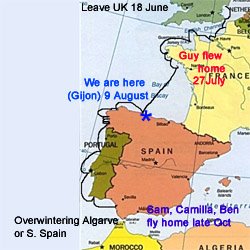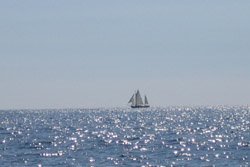We’re still in La Trinité after a couple of nights here – having experienced the worst weather we’ve had for quite some time. This must be what was forecast for Saturday! We had a good visit to the megaliths of Carnac on the local Petit Train, which takes you right along the line of several thousand standing stones. On a sunny morning in late July the stones don’t really have too much atmosphere. It would be better to come back on a gloomy day in winter, when you’re allowed to walk among the stones instead of staying behind the fence, and get some feeling of why they might be there. Broadly, no-one knows, although there are some wacky theories about them being used as astronomical graph paper. Ben reckons they were put up to celebrate people’s birthdays.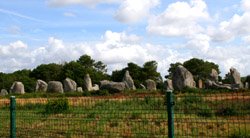
It poured with rain all yesterday afternoon, which put paid to the engineering work which Sam wanted to do (he needed to empty the cockpit locker and climb into it) and I didn’t get too much washing done either. The wind got gradually stronger and it was quite chilly – having said that we were all still in shorts, so it can’t have been too bad. We spent the afternoon reading and sleeping and by the evening were very grumpy and all wanted to go home. Ben, bless him, managed to set up his laptop as a DVD player in the forepeak so we could all three snuggle in there under our duvets, ignore the wind and rain outside, and watch Bill & Ted’s Bogus Adventure (the one with “How’s it hanging, Death?”). We felt better.
Today it’s very windy – a stall blew down in the market while we were there – so we’re in no hurry to get on. It’s very sheltered here and is probably much worse out at sea. However, the sun has come out again (so I got my washing done) and the wind is forecast to settle down a bit tomorrow. Sam is very chuffed because he has found the source of a leak which was filling the bilges – a bolt had punched a hole in one of the exhaust hoses. La Trinité is a good place for engineering works because it’s filled with specialist yacht suppliers, and he found a Volvo Penta dealer around the corner who has supplied the right kind of pipework to repair the hole. Below, a view of Sam at work in the locker...

I have more pictures but can't upload them from here (internet cafe) ... watch this space!
Sunday 30 July
Racing centre
From Lorient we headed down to Belle-Ile, which is famous for being beautiful and crowded. Instead of the main port of Le Palais (which is described in the pilot book as “like being inside a sardine tin”) we headed for Sauzon, a drying port with visitors’ moorings on the outside. Now Guy is no longer with us, we can pick up moorings without feeling too guilty. Sauzon was indeed very pretty, with wonderful clear light, and a completely flat-bottomed harbour which you can walk right across at low water (and Ben did).

Before dinner we entertained ourselves by constructing a wooden kit intended to show wave motion – when you wind a little handle, boats go up and down and a bird goes round and round (initially it flew backwards, but we managed to correct that). Barny and Mary, if you’re reading this, thank you very much – it provided us with a couple of happy hours.
On the Friday evening we picked up a slightly doubtful weather forecast, which was reinforced the next morning by another one predicting force 6 gusts – not much fun on a fairly exposed anchorage. We also saw a fairly spectacular sunset sky which, on checking in Alan Watts’ “Instant Weather Forecasting” we discovered meant strong winds within 12-15 hours. So early on Saturday, we rushed up to Port Haliguen marina at the very tip of the Quiberon peninsular. No sign of the force 6 there either, but the forecast for Sunday was even worse, with force 6 gusting 7 expected in the morning. The marina was packed with boats overnight, it poured with rain, and there was absolutely no wind at all.
Now we’re in La Trinité sur Mer, said to be one of France’s top race sailing centres. There are some spectacular racing multihulls moored just outside the marina – the sort of thing Ellen MacArthur sails around the world. This is also the home of Philippe Plisson, the photographer who takes amazing pictures of lighthouses with waves breaking over them, and there is a whole gallery full of his photos. La Trinité is full of beach-style cafes and kiss-me-quick hats, which is surprising as there’s no real beach here – the boats must be the attraction. Oh yes, and the wind is getting up – I thought it was supposed to die away?
Tomorrow we plan an educational visit to Carnac, the biggest prehistoric construction in the universe, which is a couple of miles away. With a bit of luck we’ll also be able to connect to the internet and upload this blog.
We’ll be spending a few days in and around the Gulf of Morbihan, the rocky inland sea just round the corner from here, and then we have to make a Big Decision – do we do the jump across Biscay to Spain, or do we press on down the coast of France? Crouesty, just across the Baie de Quiberon, looks like a good jumping-off point so when we get there we’ll need to collect weather info and screw up our courage. It’s about 250 miles from here to Gijon in northern Spain – the longest trip we’ve done in one go before is about 110 (from Holland to Harwich a couple of years ago). Mark can’t make it, alas, so it will be just Sam, me and Ben.
Thursday 27 July
Goodbye Guy
 We’re in Lorient, where we have said goodbye to Guy. Today he and Sam caught the train (from Lorient station, which looks just Peterborough station where I have spent many happy hours) to Nantes, where Guy flew back to the UK. Ben and I have spent the day rearranging the boat so that Ben can now use the rear cabin, where Guy was sleeping, and as a result we now have an extraordinarily clean, tidy and usable main cabin. It won’t last. The boat seems very empty and quiet without Guy.
We’re in Lorient, where we have said goodbye to Guy. Today he and Sam caught the train (from Lorient station, which looks just Peterborough station where I have spent many happy hours) to Nantes, where Guy flew back to the UK. Ben and I have spent the day rearranging the boat so that Ben can now use the rear cabin, where Guy was sleeping, and as a result we now have an extraordinarily clean, tidy and usable main cabin. It won’t last. The boat seems very empty and quiet without Guy.
From Port la Foret we spent two days in the Ile de Groix, a rocky island about the size of Alderney. We were lucky to get into the harbour at Port Tudy – although we did hope that Monday lunchtime would be a good time to arrive – and on our first night were in the middle of a raft of five boats. On the second night we had our own finger pontoon which was much more comfortable. The harbour is full of yachts coming and going, fishing boats, RIBs (rigid inflatables, of which there are thousands around here) and vedettes in the outer port, so is not exactly peaceful, but there’s always something to watch. The island is lovely with brightly painted houses, tiny sandy coves and clear, blue water.
From there we made the short hop to the big port of Lorient. Guy was asleep for the crossing and it must be especially strange for him, going to sleep in a harbour on a resort island and waking in the very middle of a French city. Having a shower is particularly odd, as you grab your towel and shampoo and cross a busy main road full of commuter traffic to the shower block across the road, which appears to be one of the few old buildings left in the city. Good showers though, and a quiet and pleasant marina despite the passing traffic.
Lorient spends most of the year being dull and concrete but at the moment is getting ready for the Interceltique, the huge 10-day festival of Celtic culture which starts next week. The Rough Guide to France is very rude about Lorient, saying that the Port de Plaisance is the only bit of colour, and looking at Kalessin with our washing flying I think we were the most colourful thing here.
Yesterday we were approached by a teacher of English who asked if we would be willing to talk to three of his students, so spent a pleasant hour in a café chatting to them. It was nice to talk to someone apart from each other!
My mama tells me that I came to Le Pouldu, which is about 10 miles outside Lorient, when I was just three months old. I looked it up in the French pilot book, to see if we could have sailed there, and it says “Le Pouldu est une veritable aventure”. The entry is difficult, you can only get in an hour before high water if there is no wind and no waves, and it has moving banks of sand, strong currents at springs and not enough water at neaps, and to top it all no room to moor anyway. All in all, I’m quite glad we missed it.
 The Lagos-bound box includes an Epirb (Emergency Position Indicating Radio Beacon) which has just cost us £500. Up to now these have been carried by ocean-crossers, but not necessarily by people doing more coastal sailing. If your boat sinks, they send out an electronic signal which transmits its location to Falmouth Coastguard, who then check with your named contacts to see if you are really at sea, and if you are, launch a rescue mission. This is either automatic (in the more expensive models), manual, or triggered when the Epirb hits the water.
The Lagos-bound box includes an Epirb (Emergency Position Indicating Radio Beacon) which has just cost us £500. Up to now these have been carried by ocean-crossers, but not necessarily by people doing more coastal sailing. If your boat sinks, they send out an electronic signal which transmits its location to Falmouth Coastguard, who then check with your named contacts to see if you are really at sea, and if you are, launch a rescue mission. This is either automatic (in the more expensive models), manual, or triggered when the Epirb hits the water.





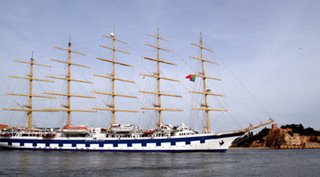


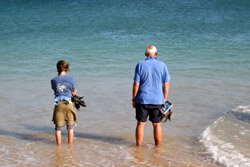
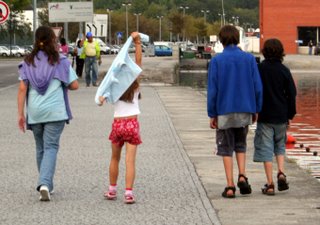




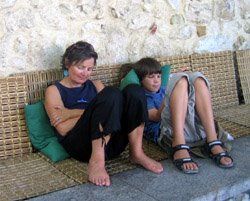
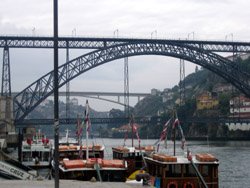

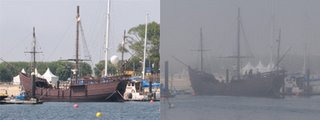

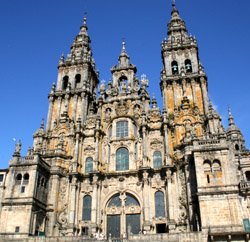
 Glorious Santiago cathedral
Glorious Santiago cathedral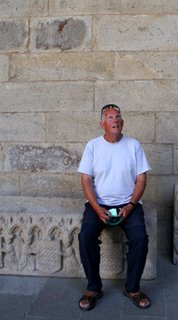



 Sunrise over the mussel farm in Corme
Sunrise over the mussel farm in Corme





